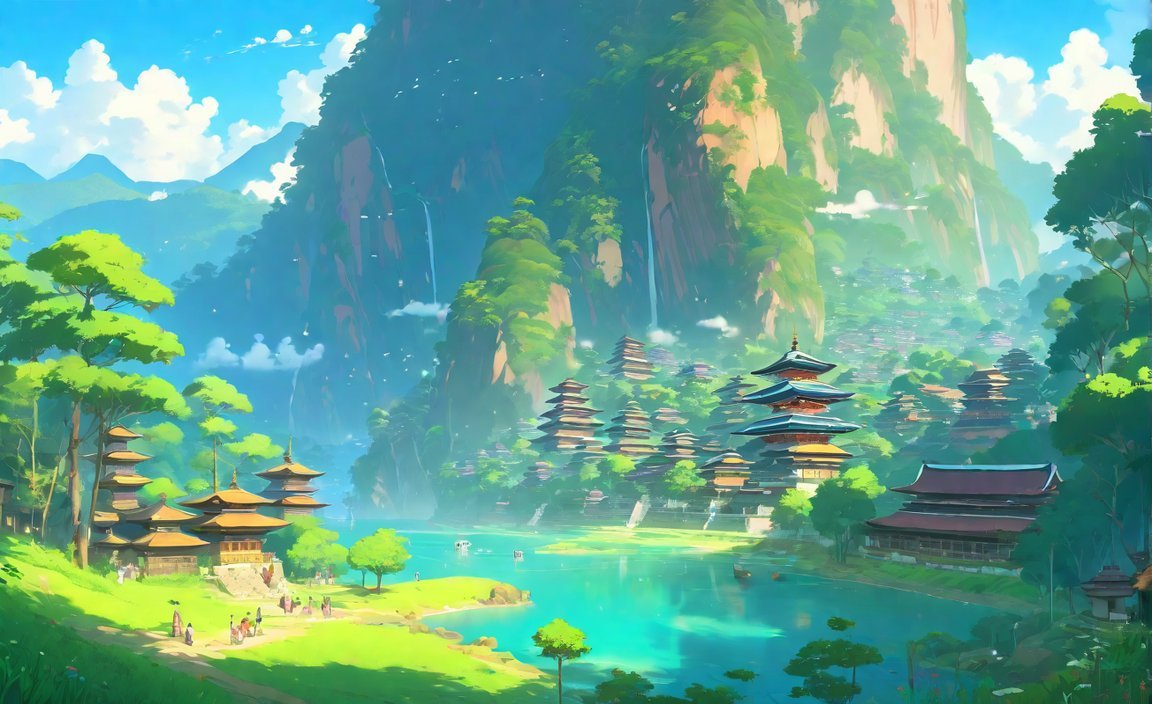Unveiling Nepal: A Landlocked Country with No Coastline is a captivating journey into the heart of this enchanting landlocked nation. Nestled within the realms of Asia, Nepal stands as a testament to the allure and mystique of landlocked countries. From its majestic mountains to its rich cultural heritage, this article will transport you deep into the wonders of Nepal, revealing the hidden gems that make it a captivating destination. Join us as we delve into the dynamic history, thriving traditions, and awe-inspiring vistas of this remarkable country without a coastline.

Key Takeaways:
1. Nepal is a landlocked country, meaning it doesn’t have direct access to the ocean, and it is surrounded by India and China.
2. Being landlocked poses challenges for transportation and trade, as Nepal relies on land routes and neighboring countries for importing and exporting goods.
3. Despite its lack of coastline, Nepal has developed its economy and attracts tourists with its stunning landscapes, including the Himalayan mountain range and Mount Everest.
4. Nepal has preserved its rich cultural heritage, with numerous ancient temples, palaces, and religious sites.
5. Nepal is one of 44 landlocked countries in the world, along with countries like Uzbekistan, which also do not have coastlines.
6. Kazakhstan, despite having a coastline on the Caspian Sea, is still considered a landlocked country because the Caspian Sea is not connected to wider seaborne trade.
Country That Has No Coastline Like Nepal
Nepal, a landlocked country nestled in Southern Asia, holds a unique position on the world map. Tucked away amidst towering giants like India and the People’s Republic of China, Nepal lacks a coastline, meaning it has no direct access to the ocean. In fact, it is one of the 44 landlocked countries that exist worldwide.
The absence of a coastline in Nepal is a result of its geographical location. Sandwiched between its neighboring nations, Nepal finds itself entirely enclosed by land. Its borders span approximately 2,925 km (1,818 miles), showcasing the nation’s landlocked expanse.
Reliance on land for transportation and trade poses considerable challenges to Nepal due to its landlocked state. Unlike countries blessed with coastlines, Nepal cannot partake in international trade through sea routes. Instead, it heavily relies on its land connections and neighboring countries to facilitate the import and export of goods.
However, despite these limitations, Nepal has carved a path towards economic growth and garnered the attention of adventure-seeking travelers. The country captures the imagination with its awe-inspiring natural wonders, including the majestic Himalayan mountain range and Mount Everest, the highest peak on our planet. These scenic landmarks contribute to Nepal’s allure and play a significant role in attracting tourists from every corner of the globe.
Moreover, Nepal remains dedicated to preserving its rich cultural heritage. Countless ancient temples, palaces, and religious sites dot the landscape, showcasing the depth of Nepal’s historical significance. With a vibrant tapestry of traditions, Nepal weaves a captivating story that beckons travelers to immerse themselves in its wonders.
While Nepal shines as a landlocked gem, it shares this unique status with other Asian countries. Take Uzbekistan, for example, sharing its borders with Kazakhstan, Turkmenistan, Kyrgyzstan, and Afghanistan. Nepal’s landlocked counterparts prove that being devoid of coastlines does not restrict a nation from embracing its own distinct beauty and cultural identity.
Interestingly, some countries find themselves in a peculiar position, holding coastlines along landlocked bodies of water. Kazakhstan stands as a prime example with its coast along the Caspian Sea, which is categorized as a lake without access to international seaborne trade. Despite having a shoreline on the Caspian Sea, Kazakhstan remains classified as a landlocked country.
To sum up, Nepal, situated in Southern Asia, is a landlocked country that gracefully embraces its lack of coastline. Surrounded by India and China, Nepal faces obstacles in terms of transportation and trade due to its landlocked status. Nevertheless, it thrives by showcasing its unique blend of natural wonders and cultural heritage to captivate the hearts of travelers.
Country That Has No Coastline Like Armenia Interesting Facts – Did you know that Armenia, with its fascinating culture and rich history, is one of the few countries in the world that is landlocked? Explore Armenia’s intriguing facts and discover more about this extraordinary nation.
Intriguing States Bordering Texas – As you delve into the diverse landscapes and vibrant cultures of Texas, take a moment to uncover the states that share their borders with the Lone Star State. Discover the hidden gems and unique experiences awaiting you in these neighboring states.
Landlocked Countries In Asia
Asia is home to several intriguing landlocked countries, which face unique challenges due to their lack of direct access to the sea. In this article, we will explore some of these countries, including their capitals, main exports, sizes, languages, and religions.
Uzbekistan
Let’s begin with Uzbekistan, the only doubly landlocked country in Asia. It shares borders with Kazakhstan, Turkmenistan, Kyrgyzstan, and Afghanistan. Tashkent serves as the capital of Uzbekistan. The country’s main exports include natural gas, gold, cotton, and uranium. With an expansive area of 448,978 square kilometers, Uzbekistan stands as one of the larger landlocked countries in Asia. The official language spoken here is Uzbek, and the majority of the population follows the Islamic faith.
Nepal
Moving on to Nepal, located in Southern Asia and bordered by India and China. Kathmandu serves as the captivating capital of this landlocked nation. Nepal is renowned for its natural beauty, particularly the awe-inspiring Himalayas. The country’s main exports encompass textiles, carpets, and handicrafts. With a land area of 147,516 square kilometers, Nepal may be relatively small compared to some other landlocked countries, but its charm is undeniable. The official language spoken in Nepal is Nepali, and the predominant religion is Hinduism.
Other Landlocked Countries in Asia
Aside from Uzbekistan and Nepal, there exist several other fascinating landlocked countries in Asia. These include Afghanistan, Armenia, Azerbaijan, Bhutan, Kazakhstan, Kyrgyzstan, Laos, Mongolia, Tajikistan, and Turkmenistan. Each of these countries possesses its own distinct characteristics and faces exclusive challenges as landlocked nations.
Sources:
– Landlocked Countries In Asia – WorldAtlas
– Landlocked Asian Countries 2023 – World Population Review
Key Takeaways:
– Uzbekistan is the only doubly landlocked country in Asia, sharing borders with Kazakhstan, Turkmenistan, Kyrgyzstan, and Afghanistan.
– Nepal, located in Southern Asia, is known for its natural beauty, including the Himalayas. It shares borders with India and China.
– Both Uzbekistan and Nepal face unique challenges in terms of trade and transportation due to their landlocked nature.
– Uzbekistan’s main exports include natural gas, gold, cotton, and uranium, while Nepal exports textiles, carpets, and handicrafts.
– Uzbekistan has a significantly larger land area compared to Nepal.
– The official language of Uzbekistan is Uzbek, whereas Nepali serves as the official language of Nepal.
– The predominant religion in Uzbekistan is Islam, while Hinduism holds sway in Nepal.

FAQ
Q1: What is a landlocked country?
A1: A landlocked country is a nation that does not have direct access to any ocean or coastline. It is surrounded by other countries and does not have a border with any body of water.
Q2: How many landlocked countries are there in Asia?
A2: There are several landlocked countries in Asia, including Uzbekistan, Nepal, Afghanistan, Armenia, Azerbaijan, Bhutan, Kazakhstan, Kyrgyzstan, Laos, Mongolia, Tajikistan, and Turkmenistan.
Q3: What are the challenges faced by landlocked countries?
A3: Landlocked countries face challenges in terms of transportation and trade. They do not have access to sea or ocean trade routes, which limits their ability to engage in international trade through water transport. Instead, they rely on land routes and neighboring countries for importing and exporting goods.
Q4: What are some natural attractions in Nepal?
A4: Nepal is known for its stunning landscapes, including the Himalayan mountain range and Mount Everest, the tallest peak in the world. These natural attractions attract tourists from around the globe.
Q5: What is the main export of Uzbekistan?
A5: Uzbekistan’s main exports include natural gas, gold, cotton, and uranium. These resources contribute to the country’s economy and trade.
- Unveiling Bernhard Caesar Einstein’s Scientific Achievements: A Legacy in Engineering - July 15, 2025
- Uncover who is Jerry McSorley: CEO, Family Man, Business Success Story - July 15, 2025
- Discover Bernhard Caesar Einstein’s Scientific Contributions: Unveiling a Legacy Beyond Einstein - July 15, 2025















